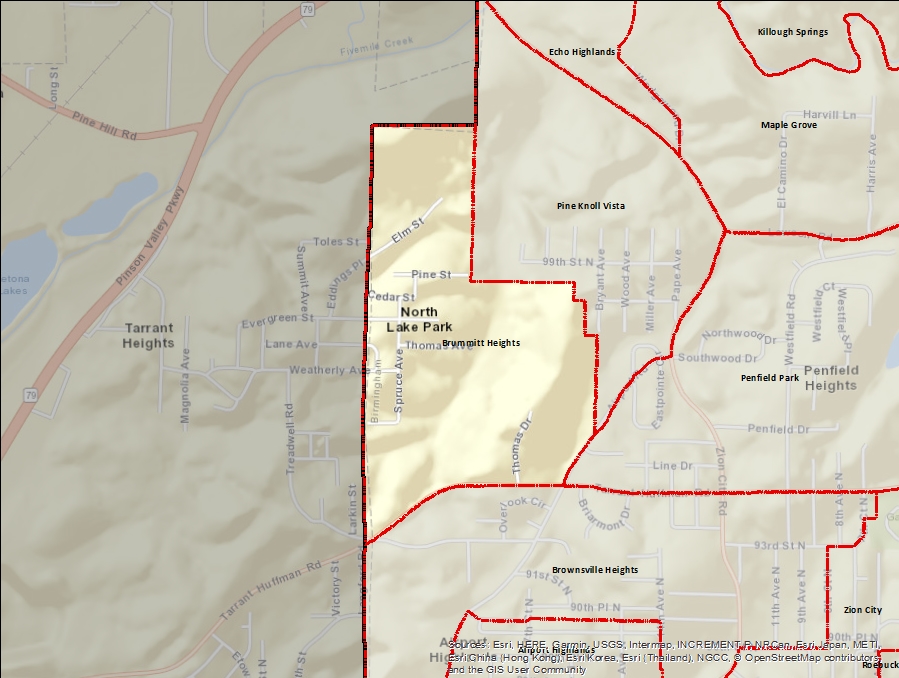Brummitt Heights
Brummitt Heights is a neighborhood in Birmingham's Airport Hills community. Much of the neighborhood lies within the ravine of a creek running from the rim of North Lake toward Five Mile Creek. Once called Tarrant Heights, extended eastward into the present municipality of Tarrant. The neighborhood's hills were first populated by black workers from nearby quarries on Huntsville Road and at Ketona in the late 1800s. More workers came after the National Cast Iron Pipe Company opened its plant.
Indicator Details
| Indicators | Primary Domain | Indicator Value |
Rank |
Tier | Indicator Weight |
|---|---|---|---|---|---|
| Blood Lead Levels in Children | Housing | -% | - | Data N/A | 1.00 |
| Low Birth Weight | Health Systems and Public Safety | -% | - | Data N/A | 1.00 |
| School Readiness Scores | Educational Opportunities | -% | - | Data N/A | 1.00 |
| Preventable Hospitalizations | Health Systems and Public Safety | - | - | Data N/A | 1.00 |
| Violent Crime | Health Systems and Public Safety | 0 | 1 | Top | 4.00 |
| Access to Parks and Open Space | Natural Areas | 100.0% | 1 | Top | 1.00 |
| Motor Vehicle Collisions | Health Systems and Public Safety | 0 | 1 | Top | 4.00 |
| Payday Loans | Economic Health | 0 | 1 | Top | 1.00 |
| Pedestrian & Bicycle Injuries by Motor Vehicles | Health Systems and Public Safety | 0 | 1 | Top | 4.00 |
| Residential Proximity to Traffic | Environmental Hazards | 0.0% | 1 | Top | 1.00 |
| Proximity to Brownfield Sites | Environmental Hazards | 0.0% | 1 | Top | 1.00 |
| School Proximity to Traffic | Environmental Hazards | 0.0% | 1 | Top | 1.00 |
| Proximity to Superfund Sites | Environmental Hazards | 0.0% | 1 | Top | 1.00 |
| Offsite Alcohol Outlets | Neighborhood Characteristics | 0 | 1 | Top | 1.00 |
| Tree Cover | Natural Areas | 68.8% | 3 | Top | 1.00 |
| Access to Mainstream Financial Services | Economic Health | 63.9% | 3 | Top | 1.00 |
| Chronic School Absence | Health Systems and Public Safety | 5.0% | 5 | Top | 1.00 |
| Abandoned Structures | Blight | 3.6% | 6 | Top | 5.00 |
| Residential Mobility | Social Cohesion | 95.3% | 7 | Top | 1.00 |
| Adult Educational Attainment | Educational Opportunities | 87.8% | 9 | Top | 3.00 |
| Public Assisted Households | Employment Opportunities | 15.5% | 10 | Top | 1.00 |
| Travel Time to Work | Employment Opportunities | 19.2 | 10 | Top | 1.00 |
| Voter Participation | Social Cohesion | 7.6% | 15 | Top | 1.00 |
| Vacancy Rates | Housing | 10.0% | 15 | Top | 1.00 |
| Visual Property Nuisances | Blight | 3.5% | 19 | Top | 5.00 |
| Toxic Releases from Facilities | Environmental Hazards | 29.4% | 20 | Top | 1.00 |
| Business Retention | Economic Health | 0.0% | 22 | Top | 1.00 |
| Excessive Housing Cost Burden | Housing | 34.0% | 24 | Top | 1.00 |
| High School Graduation Rate | Educational Opportunities | 80.0% | 25 | Top | 3.00 |
| Age of Housing | Housing | 74.6% | 27 | Top | 1.00 |
| Reading Proficiency | Educational Opportunities | 14.8% | 29 | Top | 3.00 |
| Employment Rate | Employment Opportunities | 86.9% | 32 | Top | 1.00 |
| Food Desert | Neighborhood Characteristics | 100.0% | 56 | Middle | 2.00 |
| Public Health Nuisances | Health Systems and Public Safety | 84 | 65 | Middle | 4.00 |
| Transit Accessibility | Transportation | 3.3 | 68 | Bottom | 4.00 |
| Long-Term Unemployment | Employment Opportunities | 5.0% | 75 | Bottom | 1.00 |
| Commute Mode Share | Transportation | 9.4% | 79 | Bottom | 4.00 |
| Infant Mortality Rate | Health Systems and Public Safety | 18.2 | 83 | Bottom | 1.00 |
| Preschool Enrollment | Educational Opportunities | 0.0% | 87 | Bottom | 3.00 |
| Walkability | Neighborhood Characteristics | 25.3 | 90 | Bottom | 4.00 |
| Land Use Mix | Neighborhood Characteristics | 0 | 94 | Bottom | 1.00 |
| Household Transportation Costs | Transportation | 28.5% | 95 | Bottom | 4.00 |
| Pedestrian Connectivity | Transportation | 9 | 95 | Bottom | 4.00 |
| Tax Delinquent Properties | Blight | 40.3% | 97 | Bottom | 5.00 |
| Local Business Vitality | Economic Health | 0.0% | 98 | Bottom | 1.00 |

Demographic and Contextual Indicators
| Neighborhood | City Wide | |
|---|---|---|
| Income Inequality | 0.4 | 0.49 |
| Concentrated Poverty | 6.1% | 30.9% |
| Life Expectancy | 72.6 | 78.8 |
| Population | 118 | 210,616 |
| Racial and Ethnic Diversity | 0.1 | 0.44 |
| Park Quality | 45.8 |